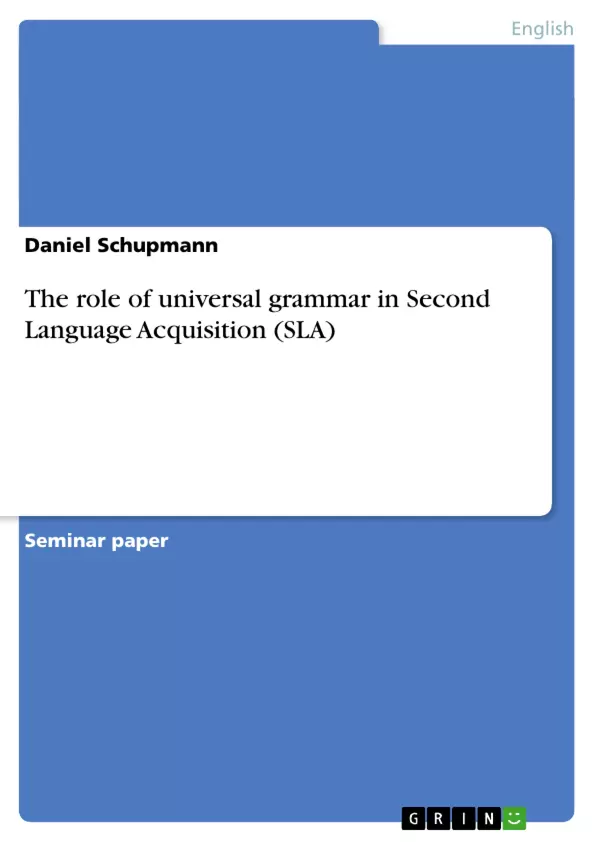This piece of work intends to present the most cogitable positions concerning the functioning of universal principles in Second Language Acquisition (SLA) as they are commonly considered to work within First Language Acquisition (FLA). It will transpire that various aspects of SLA compared to FLA do not allow for a lucid and irrevocable answer to be given for this question.
In order to give the reader an idea of what Universal Grammar (UG) deals with, the first part of the paper sets up a conception of FLA to work on the basis of innate knowledge. Special emphasis is put on the content of Input as well as the realization of UG in terms of principles and parameters. Following SLA is scrutinized more closely with respect to the acquisition process and differences concerning the preconditions of both FLA and SLA before turning to the discussion of the major positions in linguistic research.
Inhaltsverzeichnis (Table of Contents)
- Introduction
- The idea of Universal Grammar
- Introducing UG
- UG vs. Input
- Underdetermination
- Degeneracy
- Negative evidence
- Principles and parameters of UG
- UG in Second Language Acquisition
- Interlanguage grammar
- L1 and L2 in comparison
- Major positions
- UG is completely available in SLA
- UG is no longer available in SLA
- UG is partially available in SLA
- Conclusion
- References
Zielsetzung und Themenschwerpunkte (Objectives and Key Themes)
This paper explores the role of Universal Grammar (UG) in Second Language Acquisition (SLA), comparing it to its role in First Language Acquisition (FLA). It aims to examine various aspects of SLA that present challenges to understanding how UG functions in both contexts. The paper delves into the concept of UG, focusing on the role of input and the realization of UG through principles and parameters. It then investigates how SLA differs from FLA in terms of the acquisition process and preconditions before discussing major positions on the availability of UG in SLA.
- The role of Universal Grammar in Second Language Acquisition
- Differences between First Language Acquisition and Second Language Acquisition
- The concept of input and its influence on language acquisition
- The principles and parameters of Universal Grammar
- Major positions on the availability of UG in SLA
Zusammenfassung der Kapitel (Chapter Summaries)
The introduction outlines the purpose of the paper, which is to investigate the functioning of universal principles in SLA. It emphasizes the challenges involved in understanding how UG operates in both FLA and SLA. The first part of the paper introduces the concept of UG, explaining its role in FLA based on the innateness hypothesis. This section also examines the role of input data and how UG mediates between input and the final grammar of a language. The second part delves deeper into UG, exploring the "projection problem" and the three main circumstances that demonstrate why grammar rules cannot be derived solely from input. These circumstances include underdetermination, degeneracy, and negative evidence. The paper then moves on to discuss UG in the context of SLA, focusing on interlanguage grammar, the comparison between L1 and L2 acquisition, and major positions on the availability of UG in SLA. This section explores arguments for and against the complete, partial, or complete absence of UG in SLA.
Schlüsselwörter (Keywords)
Universal Grammar, First Language Acquisition, Second Language Acquisition, Input, Principles and Parameters, Interlanguage grammar, Innateness Hypothesis, Projection Problem, Underdetermination, Degeneracy, Negative evidence, SLA positions.
- Arbeit zitieren
- Daniel Schupmann (Autor:in), 2004, The role of universal grammar in Second Language Acquisition (SLA), München, GRIN Verlag, https://www.grin.com/document/32936



